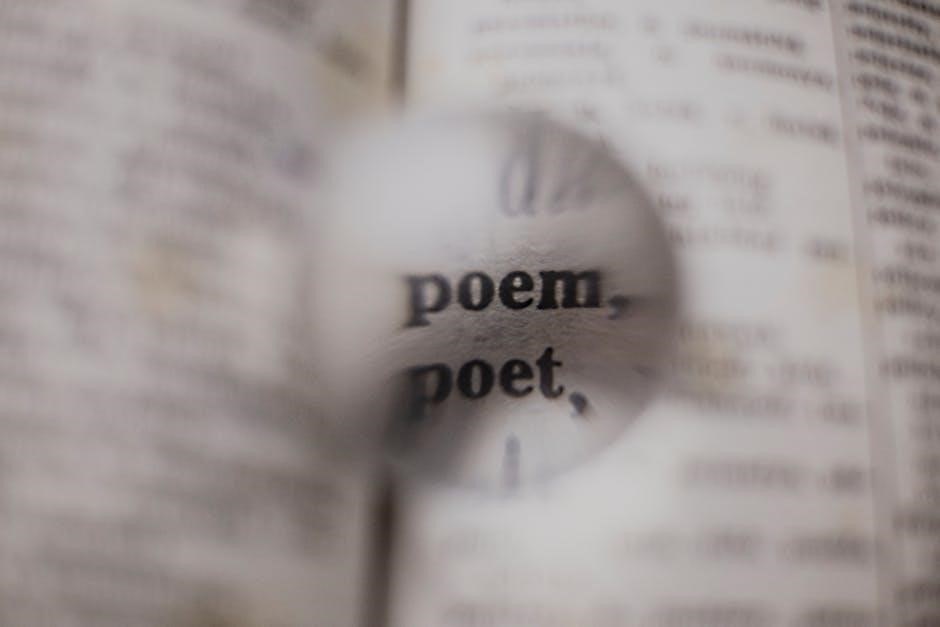Robert Browning’s “My Last Duchess” is a dramatic monologue published in 1842, exploring themes of jealousy, power, and art through the Duke of Ferrara’s unsettling portrait of his late wife.
1.1 Overview of the Poem
“My Last Duchess” is a dramatic monologue by Robert Browning, first published in 1842. The poem is set in the 16th century and revolves around the Duke of Ferrara, who speaks about a portrait of his deceased wife. Through his dialogue, the Duke reveals his possessive and jealous nature, as well as his obsession with the portrait. The poem explores themes of power, control, and the objectification of art. Browning’s use of imagery, symbolism, and irony creates a chilling atmosphere, highlighting the Duke’s darker traits. The poem’s structure and tone reflect the Duke’s psyche, making it a masterful exploration of human complexity.
1.2 Historical Context
The poem is loosely based on historical events involving Alfonso II, Duke of Ferrara, who lived in the 16th century. This period was marked by political intrigue and artistic flourishing in Italy. The poem draws inspiration from the Renaissance era, where art and power intertwined. The Duke’s character is influenced by historical accounts of noble figures known for their strict control over their households. Browning’s portrayal captures the societal norms and dynamics of the time, where women were often objectified and controlled by their husbands. This context enriches the poem’s themes of possession and authority, adding depth to the narrative.

1.3 Robert Browning’s Style

Robert Browning’s style in “My Last Duchess” is characterized by his mastery of the dramatic monologue, which immerses readers in the Duke’s psyche. Browning employs vivid imagery and subtle irony to convey the Duke’s possessiveness and jealousy. His use of dialogue creates a sense of immediacy, allowing the Duke’s darker traits to emerge naturally. The poem’s language is both elegant and chilling, reflecting Browning’s ability to blend beauty with moral complexity. This style not only reveals the Duke’s character but also critiques societal norms, making the poem a powerful exploration of human nature and artistic expression.
The Duke of Ferrara: Character Analysis
The Duke of Ferrara is a complex, manipulative figure with a dark, controlling personality, driven by jealousy and a twisted sense of possession.
2.1 The Duke’s Personality Traits
The Duke of Ferrara exhibits a narcissistic and manipulative personality, revealed through his obsessive admiration of the portrait of his late wife. His controlling nature is evident in his desire to possess and dictate how others perceive the Duchess. The Duke’s speech is laced with a condescending tone, showcasing his arrogance and sense of superiority. His fixation on the portrait highlights his possessiveness and inability to let go, while his casual mention of her demise underscores his ruthlessness and lack of empathy. These traits collectively paint a chilling portrait of a man consumed by jealousy and power.
2.2 Psychological Insights
The Duke’s monologue reveals a deeply narcissistic and paranoid mindset, driven by an obsessive need for control; His admiration for the portrait conceals a darker psychological truth—his inability to tolerate imperfection or independence in others. The Duchess’s smiles and joy, interpreted as disloyalty, trigger his possessive jealousy, highlighting his rigid expectations of devotion. His calm demeanor contrasts chillingly with the brutality of his actions, suggesting a calculating psychopathy. The Duke’s psychology is rooted in a toxic mix of pride, entitlement, and an inability to empathize, transforming him into a symbol of dangerous egotism and unchecked power.

2.3 Historical Inspiration
The poem is loosely based on the life of Alfonso II d’Este, the Duke of Ferrara in the 16th century. Browning drew inspiration from the mysterious death of the Duchess, which was rumored to be orchestrated by her husband due to jealousy. Historical records suggest the Duke’s controlling nature and obsession with power, traits mirrored in the poem. Browning adapted these events to create a fictionalized account, blending history with artistic license to explore themes of jealousy, possession, and the darker aspects of human nature. The historical context adds depth to the Duke’s character, making his actions both plausible and chilling.

Themes in “My Last Duchess”
The poem explores jealousy, possessiveness, power dynamics, and the objectification of art, revealing the darker aspects of human nature through the Duke’s unsettling narrative.
3.1 Jealousy and Possessiveness
The Duke’s monologue reveals his consuming jealousy and possessiveness, as he obsesses over the Duchess’s perceived flirtations. His rigid control reflects a toxic desire to own and silence her.
3.2 Power Dynamics
The poem highlights a stark power imbalance, with the Duke exerting control over the Duchess through possession and dominance. His ownership of her portrait symbolizes his authority, as he dictates how she is perceived and remembered. The Duke’s need to command her smile and his frustration with her inability to reserve it solely for him underscore his possessive nature. This dynamic reflects the societal norms of the time, where women were often objectified and stripped of agency. The poem critiques such power structures, revealing the darker side of patriarchal control and the suppression of female autonomy.
3.3 Art and Objectification
In My Last Duchess, art serves as a tool for objectification, with the Duke using the portrait to exert control over his late wife. The painting, created by Frà Pandolf, captures her likeness but freezes her in a static, idealized form, stripping her of agency. The Duke’s obsession with the portrait reflects his possessive nature, as he seeks to own and commodify her image. This dynamic illustrates how art can perpetuate power imbalances, reducing the Duchess to a mere object of admiration and control. The poem critiques the commodification of beauty and the tragic consequences of such objectification.

Literary Devices and Structure
Robert Browning’s My Last Duchess employs a dramatic monologue structure, using imagery, symbolism, and irony to explore themes. The poem’s form enhances its psychological depth and tension.
4.1 Dramatic Monologue
My Last Duchess is a masterful example of a dramatic monologue, where the Duke of Ferrara reveals his character and motives through a single, uninterrupted speech. This literary device allows Browning to create psychological depth and tension, as the Duke’s thoughts and feelings are expressed directly to the reader. The monologue format enables the exploration of complex themes like jealousy, power, and objectification, while the Duke’s voice provides a chilling insight into his mindset. Browning’s use of this technique emphasizes the intimate yet unsettling nature of the narrative, making the Duke’s revelations both personal and profound.
4.2 Imagery and Symbolism
Browning’s use of vivid imagery in My Last Duchess creates a powerful visual and emotional landscape. The portrait of the Duchess, described as lifelike, symbolizes her eternal presence and the Duke’s obsessive control. The setting, with its opulent decor, reflects the Duke’s wealth and status, while also hinting at his oppressive nature. The artist Frà Pandolf’s skill is emphasized, highlighting the Duchess’s beauty and the Duke’s admiration turned possessive. These symbols and images collectively paint a haunting picture of love turned to possessiveness and the Duchess’s tragic fate, reinforcing the poem’s dark and haunting atmosphere.
4.3 Irony and Tone
The tone of My Last Duchess is calm and polite, yet laced with underlying ruthlessness, as the Duke recounts his wife’s demise with unsettling composure. Browning employs irony through the Duke’s courteous demeanor, which contrasts sharply with his dark, possessive nature. The Duke’s admiration for the portrait and his casual discussion of the Duchess’s death reveal a chilling disconnect. This ironic tone underscores the poem’s themes of power and control, while the Duke’s matter-of-fact delivery heightens the sense of horror, making his revelations all the more unsettling and revealing of his true character.
The Role of Art in the Poem
Art in My Last Duchess serves as a reflection of the Duke’s psyche, with the portrait symbolizing his obsession and control. The Renaissance masterpiece embodies possession.
5.1 The Portrait of the Duchess
The portrait of the Duchess, painted by Frà Pandolf, is a central element in the poem, capturing her vibrant personality and beauty. The Duke describes it with pride, emphasizing its lifelike quality and the skill of the artist. The painting symbolizes the Duchess’s youth and joy, contrasting with the Duke’s darker, possessive nature. Through the portrait, Browning highlights the tension between art and reality, as the Duchess is immortalized yet objectified. The image serves as a reflection of the Duke’s control and his inability to appreciate her humanity, revealing deeper themes of possession and power in their relationship.
5.2 Art as a Reflection of the Duke’s Psyche
The portrait of the Duchess, painted by Frà Pandolf, mirrors the Duke’s psyche, revealing his possessive and controlling nature. The Duke’s admiration for the painting is intertwined with his jealousy, as he sees it as a permanent possession, unlike the living Duchess. His meticulous descriptions of the artwork highlight his obsession with perfection and control. The portrait symbolizes his inability to embrace life’s impermanence, instead opting to immortalize the Duchess as an object of his desire. This fixation underscores his narcissistic tendencies and the psychological turmoil driving his actions, making the portrait a chilling reflection of his inner world.
5.3 The Artist Frà Pandolf
Frà Pandolf, the artist behind the Duchess’s portrait, is portrayed as a master of his craft, whose skill in capturing life-like detail astounds the Duke. The Duke’s admiration for Pandolf’s work underscores the Renaissance reverence for artistic mastery. The painting’s lifelike quality reflects Pandolf’s ability to immortalize the Duchess, aligning with the Duke’s desire to possess and control. Pandolf’s role is pivotal, as his art becomes a tool for the Duke’s narcissistic display of wealth and power, symbolizing the fusion of art and vanity in the Renaissance aristocracy. His craftsmanship serves the Duke’s ego, highlighting the interplay between creator and patron.

The Duchess: A Tragic Figure

The Duchess emerges as a tragic figure, her vibrant life reduced to a static portrait, symbolizing the objectification of women and the Duke’s oppressive control.
6.1 Her Character and Behavior
The Duchess is portrayed as lively and kind, with a warm smile that captivated all, including the artist Frà Pandolf. Her joyful nature and grace are evident in the portrait, which the Duke describes with a mix of admiration and possessiveness. However, her cheerful demeanor is contrasted with the Duke’s dark, controlling personality, suggesting that her natural beauty and happiness were perceived as threats. The Duchess’s character is revealed through subtle details in the Duke’s monologue, highlighting her innocence and the tragic end to her vibrant life.
6.2 The Mystery of Her Death
The Duchess’s death remains shrouded in mystery, as the poem never explicitly reveals the circumstances. The Duke’s monologue hints at her demise, suggesting it was orchestrated due to her failure to meet his expectations. Her lively nature and alleged flirting with others angered him, implying a tragic end. The exact method of her death is left to the reader’s imagination, adding to the chilling effect. This ambiguity underscores the Duke’s ruthlessness and the oppressive power dynamics of their relationship, leaving a haunting enigma that aligns with the poem’s dark, gothic undertones.
6.3 The Duchess as a Symbol
The Duchess serves as a symbol of innocence, beauty, and the objectification of women. Her portrait, described as lifelike, represents her frozen existence under the Duke’s possessive gaze. She embodies the tragic consequences of patriarchal control and jealousy. The Duchess also symbolizes the conflict between artistic idealization and the realities of human life. Her fate reflects broader societal issues, such as the silencing of women and the dangers of unchecked power. Through her, Browning critiques the commodification of human beings, turning her into a haunting symbol of lost potential and the darker aspects of human nature.
